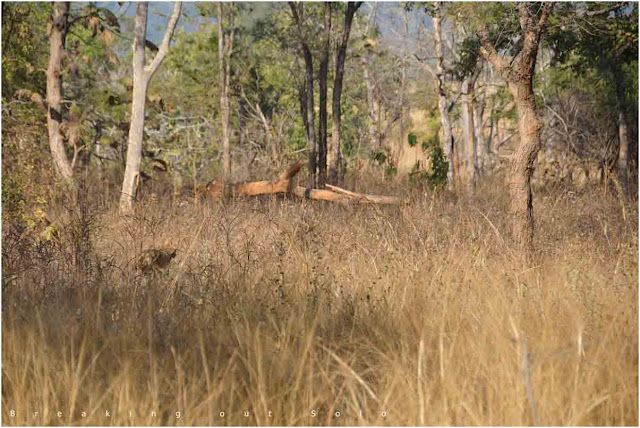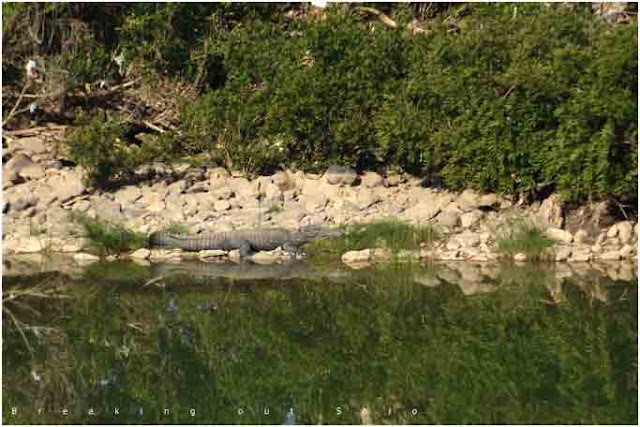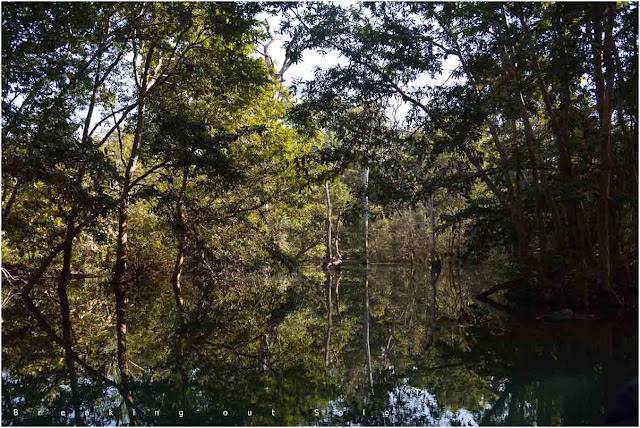We had started from
Chitrakoot early in the morning, stopping by
Kalinjar fort for a short visit. Panna is about 150 kms from Chitrakoot through sparse traffic. As we crossed the Ken river and whizzed past the sign of Camp Panna resort, our accommodation for overnight stay, the clock was showing half past one. Since jungle safaris are closed on Wednesday evenings, we had the afternoon free and decided to visit
Khajuraho, situated less than 50kms from Panna. Called up the resort and told them about our late arrival.
By the time we came back to Panna, it was already dark. The resort is about 2kms from the main road as we followed the signs. The tarmac soon disappeared as we took a right turn and was riding through complete darkness on winding village roads. Only realised in the morning that we were going through farmlands and not the forest as we had imagined. Eventually there was light at the end of the road as there, by the river Ken, was Camp Panna. The forest sprawled on its opposite bank. The staff said they would frequently see crocodiles basking in the sun and sometimes other animals would turn up as well. It was a busy time of the year and the place was fully booked. A bonfire was lit up to counter the December chill under clear starry skies. The rooms are rustic yet have a touch of luxury and the freshly cooked food was delicious.
The morning safari had been pre-booked weeks ago. We wrapped up warm as we got on our waiting open top Gypsy at 5:30 am. A breakfast of bread and butter and a flask of hot tea was packed by the staff, kept well hidden from the wild animals. Though six people are to be accommodated in each Gypsy, it felt comfortable with four. Six would leave with no space for movement. We were at the Madla gate in fifteen minutes as we picked up our guide. A form of identity had to be presented as well.
At six the gates opened and the sea of Gypsies crashed in. I have never had much luck with wild animal sighting, and with the ruckus around, had a sinking feeling in my stomach. The forest was still waking up, a light mist blanketed the trees in the winter morning. A group of Sambar deer were up ahead on the road but ran into the forest as the Gypsies arrived. My optimism sank even lower. Eventually the Gypsies went separate directions and the traffic lightened. However, unlike the much bigger Kanha reserve forest which we had visited a couple of years back, Panna's 550 sq km area with only twenty percent open for safaris meant there were always a few Gypsies around for company. In Kanha, once we were deeper inside the forest, we barely met the others.
I always find a ride through the forest fascinating and Panna with the Ken flowing through it, streams crisscrossing, deep gorges and majestic waterfalls, is considered one of the most beautiful forests. However, the dry winter is not the best time to find the forest at its best with the water lying low and the dry deciduous losing their leaves. The majestic gorge of Dhundhua falls was dry as vultures perched on ledges by the steep cliff edges.
Sambar deer and Cheetal roamed the jungles and we spotted them in abundance. Monkeys swung from the tree tops. We even spotted a couple of Nilgai and a jackal scurrying into the tall grass. A wild cat was trotting along the path ahead of us but hid in the bush as our Gypsy approached.
Panna reserve forest on the Vindhyachal range, unlike its siblings on the Satpura range hasn't had much luck with tigers. A couple were relocated from Pench and Bandhavgarh forests and the numbers are gradually increasing, reaching to about twenty. Though the evidence of the tigers was visible in their foot prints, we never saw one in person. The closest we got to see the big cats was a leopard which had been peeping through the dense grassland but disappeared as we approached.
As we were ending the five hours safari were rewarded by a heartwarming evidence of animals collaboration. A couple of monkeys were swinging on trees to bring them closer for the deer to feed as others sat around the group, probably looking for berries. If danger approached they would be the first to call out.
It was almost eleven as we approached the Mandla gate, the end of the safari. A herd of Cheetal crossed the path, and our Gypsy waited for the traffic to pass, jungle rules.
Here's sharing some photographs from the safari.
 |
| Sambar family in the early morning forest |
 |
| Indian roller |
 |
| A young Sambar deer catches the early morning light |
 |
| Morning in the forest |
 |
| A male Sambar deer |
 |
| Look out |
 |
| The troop looks on |
 |
| Monkeying around |
 |
| Nilgai |
 |
| Green pigeons flock on the trees |
 |
| Red heads |
 |
| A wild cat trots through the forest path |
 |
| A jackal disappears in the wild grass |
 |
| The gorge of the Dhundhua falls |
 |
| Vultures roost |
 |
| Weaver bird nests |
 |
| Monkeys helping the Cheetal by lowering the branches |
 |
| Ken river flows through the forest |
 |
| Crocodile basking in the sun |
 |
| Serpent eagle |
 |
| Curious onlookers |
 |
| A Sambar mother protects her child |
 |
| Sambar kiddo |
 |
| Beautiful reflections, a quiet spot and a favourite haunt for the tigers in summer |
 |
| Cheetal crossing |


























Great post. Brings back memories...
ReplyDelete